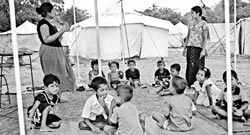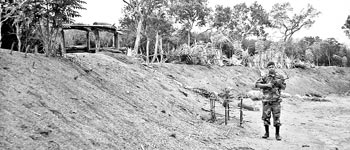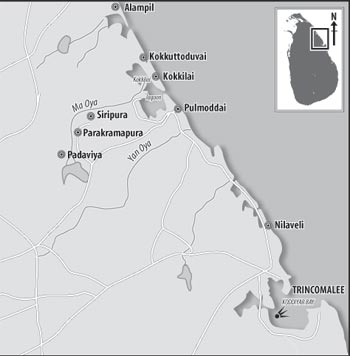
Wail from Weli OyaDisplaced several times in the past and now once again since May, villagers from Etha Wetunu Wewa in Weli Oya live a miserable existence in a camp in Parakramapura A tense standoff between 86 families totalling several hundred persons who had fled Etha Wetunu Wewa, Weli Oya and had become unwelcome guests in a displaced camp on the grounds of Parakramapura Central College as they were becoming an obstruction to the smooth functioning of the school and posing a health hazard came to an end on Friday after the displaced people finally dismantled their tents and returned to their former abodes. Nearly the entire village of Etha Wetunu Wewa comprising some 322 households fled the village on May 31, during a vicious round of shelling by the LTTE that killed a home guard and injured four civilians. While most of them eventually returned, a quarter of the families refused to budge till they were provided adequate security as they had been subjected to similar ordeals on several occasions in the past, including 17 of them being hacked to death by Tigers in 1988. The Tigers had been keeping up the pressure by regularly shelling the village since they fled. The village was shelled twice last week, while we were in the region and it got hit by two shells early this week.
On Wednesday, June 20 when we attempted to visit the major flash points in the area, we found that it was a no go area. Though we were promised easy access, once we reached the approaches to Etha Wetunu Wewa, where there is frequent shelling, we could not proceed beyond a security barrier without permission. We wasted nearly one hour trying to reach the area commander Maj. Gen. Nimal Jayasuriya to get his permission without success, as he was out on an inspection tour. The cell phones we carried were not very effective in the area either. Later we learnt from NGOs that from recent days they too are barred from proceeding beyond Bogaha Junction, Padaviya. Only the ICRC is provided ready access to Weli Oya on request. Security concerns understandably are upper most in the minds of security forces there. Just the previous day the LTTE had ambushed a security forces patrol east of nearby Janakapura killing one soldier and wounding two others. When we visited the region in 1999 during the “Jaya Sikurui” debacle, the LTTE had some precise intelligence to target the Parakramapura temple and the code words they had used to identify it to gunners were “the yellow house”. One shell nearly scored a direct hit on the temple. For our luck however it struck a nearby coconut tree splitting it in half. And it certainly taught us a good lesson to duck. When the whistling noise of an earlier shell was heard some soldiers who were in the temple shouted:”down, down” to everyone. We being greenhorns merely crouched where we were, instead of diving for cover and the thunderous explosion in a nearby paddy field soon afterwards, though it caused no harm to anyone, taught us to dive for cover ever after. So when the whistling sound of the second incoming shell was heard, I quickly dived behind a half wall of the preaching hall of the temple and when the soldiers shouted for everyone to take cover, photographer Pushpakumara Matugama too jumped over the same half wall and landed on top of me, nearly breaking my back. When we visited the displaced camp at Parakramapura there was much tension and suffering there. All 86 families were housed in small tents provided by the ICRC. The facilities were abysmal to say the least. There were just 20 toilets, no electricity and families were cooking just outside their tents on few kitchen utensils provided to each family again by the ICRC. The assistance provided by the government was a measly Rs140 worth of dry rations per week per person issued by the cooperative. By this week people complained that the cooperative did not have the goods to disburse even the measly ration.
To heap further misery six barrels provided by the police for camp inmates to store water were taken away on Wednesday allegedly to meet the needs of thousands of pilgrims expected to converge on Mihintale for Poson. Leader of these displaced persons D.W. Priyantha Kumudu Dissanayake was an angry and a disappointed man when we met him at the camp last Wednesday. He said they were not used to being reduced to beggars, and the only reason they had remained in the camp under trying conditions was they had no choice as not a day went by without a shell hitting their village. He said this was the fourth time they had been forced to flee and they were sick of running for their lives. The new 26 km. bunker line that had been built from Weli Oya to Dutuwewa after the claymore attack on a packed passenger bus at Kebetigollewa on June 16, 2006, was too close to their village for comfort. In fact, their tank bund had become the bunker line. He wanted the bunker line shifted at least two kilometres to the north to feel safe in the village, as it had been prior to the debacle of 1999. But security forces argue that shifting it a little distance would make no difference as Tigers have longer range mortars than the ones they utilize now. Tigers are mainly firing 81mm mortar, which has a range of 4.5 kilometres from the thick jungles of Mullaitivu district. The retaliatory fire has so far failed to take out this gun. It is believed that the gun is fitted to a trailer and the LTTE moves the piece before our gunners return the fire. The nearest Tiger held town is some 60 kilometres away at Kokkuthuduwai. Besides the existing bunker line has its own security vantages and a two kilometre adjustment is no small effort either having to muster a large number of additional personnel. Finally Priyantha said they were willing to go back if the government constructs a bunker for each house in the village. But according to security sources this too is a tall order as those people are expecting underground bunkers with reinforced concrete tops, whereas even military camps facing LTTE attacks make do with dug outs with logs and sand bags above them. Resettlement Minister Rishard Bathiudeen however told The Sunday Times, he was in consultation with the army and the Reconstruction Ministry to work out a scheme to build bunkers in the village. The government estimate of the cost of a rudimentary reinforced concrete top bunker is Rs.139,000, but Priyantha says if assistance was given to them they could build it for Rs 50,000. The biggest question is whether the government reeling under the terrible cost of the war coupled with increasing cuts in donor assistance, can afford such additional expenditure as it is not only this village that is under artillery threat, but many others. Settlers of Weli Oya have many other grievances, which they have been complaining about from the 1980s, but to date authorities have not come up with any solutions. For example Etha Wetunu Wewa belongs to the Vavuniya district, but when their children are selected for universities, they are counted from Anuradhapura where the cut off mark is 15 points above Vavuniya. They have no Pradeshiya Sabha of their own to get any local services. In all Pradeshiya Sabhas, each PS member is entitled to an allocation of Rs.10 million per year to attend to their respective area development work in addition to services provided by the PS. So here no such local work gets done as there are no PS members. Last time when he wanted to contest the Pradeshiya Sabha elections, Priyantha had to hand in his nominations at the Vavuniya Kachcheri. Since then the local polls have been postponed thrice. Similarly, some other parts of Weli Oya belong to the Mullaitivu District and some others to the Anuradhapura District. Priyantha also complains of other acts of discrimination. For example, he says a Samurdhi recipient family of five in Etha Wetunu Wewa is only entitled to Rs 640 worth of rations per month, but a similar size family from Parakramapura is entitled to Rs1200 worth of rations. When we raised these grievances with Divisional Secretary Padaviya, P.P.S.J de Soysa, he said they were all facing grave shortcomings and the affected people should realize that the government officials like him serving there cannot solve problems such as there being no Pradeshiya Sabha to represent them or them being divided among three districts or their children being penalized at university entrance stage. Recently when the GA Anuradhapura had come there some of the affected people had even turned abusive. Mr. de Soysa said the government in trying to take the administrative structure closer to those people has now posted an Assistant Divisional Secretary to the nearby village of Sampathnuwara and this ADS from his own SLAS batch had taken this lower post and come there voluntarily as he wanted to serve those neglected people, but he is not paid the special allowance he is entitled to for doing such work. Similarly the Padaviya Divisional Secretariat is entitled to have a clerical cadre of 23, but it has only ten clerks. But Priyantha asks why the authorities are not appointing a Divisional Secretary with full powers to serve them, instead of an Assistant Divisional Secreatary. There have also been broken promises in the past as regards compensation, some of the affected people showed entitlement certificates for compensation given to them when they returned to their village after the violence of 1999. To this date they had not received such compensation from the Rehabilitation and Reconstruction Ministry, they said. The displaced people from Etha Wetunu Wewa had even taken their woes to President Rajapaksa on June 06 and on undertakings given to them there they had agreed to go back to their village the following day, but on the same day the Tigers had again fired at the village.
|
|| Front
Page | News | Editorial | Columns | Sports | Plus | Financial
Times | International | Mirror | TV
Times | Funday
Times || |
| |
Copyright
2007 Wijeya
Newspapers Ltd.Colombo. Sri Lanka. |


 Weli Oya (Manal Aru in Tamil) has been a bone of contention from the beginning of the ethnic conflict. When the Tamil rebel movements began their violent campaign to establish an Eelam comprising the North and East, one of the first things that the nationalist elements in the then J.R. Jayewardene Government did was to settle Sinhalese in this stretch of land ending at the Kokilai lagoon, tracing ancient Sinhala habitats and thereby effectively ousting Tamils who were there. The idea was to drive a wedge into the claim for a contiguous Eelam. Already there were Sinhalese resettled up to places like Somapura, which even has an ancient temple, Chetiyagiriya Raja Maha Viharaya with some of its ruins intact.
Weli Oya (Manal Aru in Tamil) has been a bone of contention from the beginning of the ethnic conflict. When the Tamil rebel movements began their violent campaign to establish an Eelam comprising the North and East, one of the first things that the nationalist elements in the then J.R. Jayewardene Government did was to settle Sinhalese in this stretch of land ending at the Kokilai lagoon, tracing ancient Sinhala habitats and thereby effectively ousting Tamils who were there. The idea was to drive a wedge into the claim for a contiguous Eelam. Already there were Sinhalese resettled up to places like Somapura, which even has an ancient temple, Chetiyagiriya Raja Maha Viharaya with some of its ruins intact.